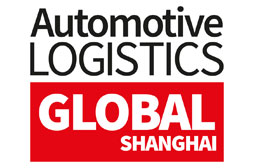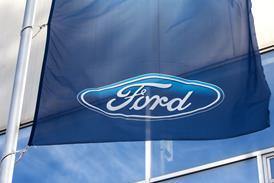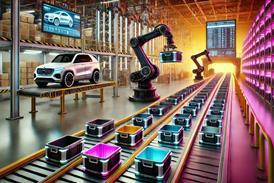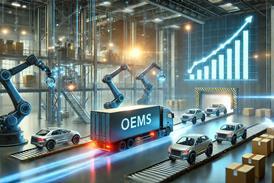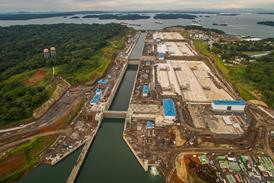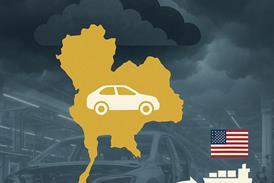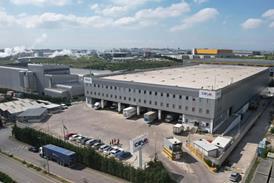EV supply chain features – Page 11
-
 Feature
FeatureThe rules of the battery game
Logistics providers charged with the transport of lithium-ion batteries to the assembly lines and services centres have some very complex regulatory standards to which they have to adhere – it is a legislative jungle out there
-
 Feature
FeatureIs Sony’s Vision S a scary sight, or a revelation for carmakers and suppliers?
Should automotive manufacturers and the supply chain fear or embrace this surprise announcement from the consumer technology giant?
-
 Interview
InterviewMena aftermarket: Playing a bigger part
Overall economic growth may be lacklustre, but automotive aftermarket sales are on the increase in the Middle East and North Africa…
-
 Feature
FeatureQ&A: Pascal Trummer, Magna International
The tier supplier’s vice-president of sales and marketing in Europe discusses major trends in the automotive industry, plus the state of the market in Central and Eastern Europe
-
 Feature
FeatureKeeping calm: RNM Alliance’s Mark Sutcliffe on how to handle supply chain volatility
The automotive industry is undergoing a technological transformation and facing upheavals in key markets, but the OEM’s senior vice-president of industrial strategy and supply chain management believes there are ways to successfully tackle these changes
-
 Feature
FeatureSuppliers set CEE on firm foundations
In the decades since the end of the Cold War, Central and Eastern Europe (CEE) has been attracting automotive components suppliers by virtue of its cheap labour, low taxes and convenient geographical location. Now, the region is aiming to maintain or even build on its gains in the face of vehicle electrification, rising global competition and other challenges.
-
 News
NewsMiddle East and North Africa: Leading the way in innovation
Despite a sustained period of decline over the last few years affected by a fall in oil prices and geopolitical strife, the Middle East and Africa is fast becoming a region of automotive and supply chain opportunity…
-
 Feature
FeatureGalvanising the aftermarket for an electric future
The rise in EVs in Europe will have an impact on the aftermarket and the logistics supporting it, not least in the management of replacement lithium batteries
-
 Feature
FeatureSuppliers will charge the change: opportunities in the EV value chain
While much focus is put on OEM plans to launch more electric vehicles, a great deal of the technology, value, production and services will come from both existing and emerging suppliers across the value chain. We expect many new opportunities for these companies over the next decade.
-
 Feature
FeatureFCA–PSA fusion: first of the electric shock waves?
The merger attempt by FCA and PSA will be complicated but makes economic and operational sense, including for supply chain management and logistics. Whether or not it goes ahead, more consolidation is likely as the automotive industry gears up for electrification
-
 Feature
FeatureYou gotta carry that weight: how bigger vehicles and EVs will challenge logistics
With forecasts for strong growth in marketshare for electric vehicle and hybrid vehicle sales over the next decade, moving parts and vehicles will require new equipment, processes and standards across OEMs and logistics providers
-
 Feature
FeatureGlobal trade disputes could dim electric vehicle supply chain potential in key markets
Trade uncertainties such as those between the US and China, or the UK and the EU, could put the brakes on growth in the electric vehicle and battery supply chain for some OEMs and countries, despite bullish forecasts for alternative powertrains
-
 Feature
FeaturePowertrain forecast to 2030: Navigating the road to electrification
Download this report for forecasts of eight different powertrains across regions, including all degrees of hybridisation, electrification and internal combustion engines, which reveal changes that will have huge implications for the future of the automotive supply chain. The latest insight by the business intelligence unit of Automotive from Ultima Media
-
 News
NewsSlovakia stays strong in straightened times
The news announced earlier this year that Volkswagen (VW) was going to scrap 3,000 of the 15,000 jobs at its Slovakian plant came virtually out of the blue and sparked off speculation that the country’s authorities might have been so absorbed with labour reform during the ongoing election campaign that they have unintentionally made the domestic automotive sector less attractive for foreign investors.
-
 Feature
FeatureCEE: At the heart of Europe’s electric future
OEMs and tier suppliers are investing in Central and Eastern Europe with a particular focus on electric, connected and autonomous mobility. Delegates at the Automotive Logistics CEE Summit in Budapest heard about the latest challenges and opportunities.
-
 Feature
FeatureWhat took the air out of Dyson’s electric car project?
The iconic manufacturer of vacuum cleaners has cancelled plans to develop and build an EV. That was probably a smart decision, considering the huge costs, competition and struggling market that Dyson would have been entering.
-
 Feature
FeatureOEMs’ profit strategies today could hurt them tomorrow
Ahead of stringent EU emissions targets starting in 2020, some carmakers are pursuing strategies that actually go against what they will ultimately need to do to reduce hefty fines. This makes sense – but only for now
-
 Feature
FeatureEU fines and electric future not entirely in the hands of OEMs
In the face of government and citizens’ rising concern over climate change, vehicle emission regulations around the world are tightening, especially in Europe. In our latest business intelligence report, we forecast that carmakers will face hefty fines under tightening vehicle emission targets, driven largely by factors outside their control.
-
 Feature
FeatureOpportunities ahead for automotive OEMs and tier suppliers
The downturn in automotive sales volume creates many challenges, but the transitional state of the industry also provides many business opportunities, according to a forecast and report from Ultima Media.
-
 Feature
FeatureGreater expectations: brighter days will return for the automotive industry
Although automotive OEMs will face years of stagnant vehicle sales, a stronger recovery thereafter will bring growth back up to long run averages and herald a return to stronger profits. By then, however, the industry is likely to have undergone further consolidation.
